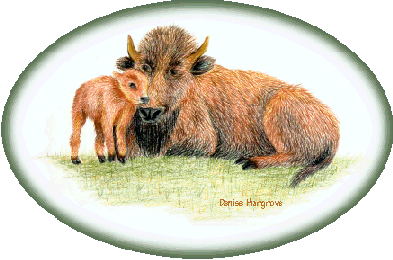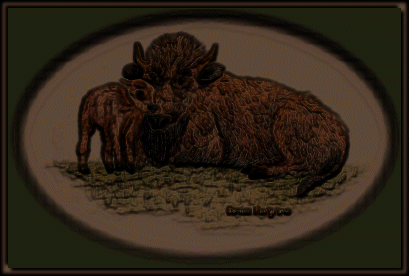


Opinion is a flitting thing,
But Truth, outlasts the Sun-
If then we cannot own them both-
Possess the oldest one-
----Emily Dickinson
The truth is that throughout the 19th century the American Bison (commonly refered to as buffalo) were massacred. The widely accepted figure is of 63,115,200 animals. The worst in American history. This figure sounds large, but it is difficult to comprehend how many animals exactly that was. Ed park, author of "The World of the Bison", answers the incomprehensible :
|
"Imagine a long, single-file column of buffalo, head to tail, walking past you, one every two seconds. Take a counter and start counting them - one every two seconds, hour after hour, day after day - without pause. During the first minute 30 buffalo would file past; in the first hour 1,800 would go by. If you could stay awake for the first twenty-four hours, you would count 43,200 buffalo. The days would roll by and sometime during the twenty-fourth day the one millionth buffalo would hurry past. Months would drag by, the seasons would change, and you would become tired of counting. Buffalo adding up to several millions would have passed before your eyes in seemingly endless file, with still more to come. At the end of the first year your counter would show a total of 15,768,000 buffalo. But the end would not be in sight! The second year would pass, then the third, and finally the fourth, with even an extra day added for a leap year. As the fourth year drew to a close, the last buffalo would hurry by, and you could look at your counter one last time! 63,115,200!"
|
Ever since I have read this, I have not been able to forget this. I came across this in a book that I highly recommend for anyone who loves animals. It is called "Ranch of Dreams" by Cleveland Amory. I figured the least I could do was to spread this information through this website, since it is a relatively unknown fact. Native Americans had coexisted with these animals, who roamed much of North America, so why couldn't the others who moved across the country? Reasons for such slaughter? - Mostly for sport is the best answer anyone could come up with. They were easy prey with their poor eyesight, poor hearing, only moderate sense of danger, and they even traveled in herds.

Bison are still being persecuted, only this time it is for different reasons - a disease called Brucellosis. Brucellosis is a sometimes fatal disease which can infect humans with undulant fever. The real problem is not human infection, but domestic cattle infection that is causing the problem. Bison that stray off protected lands can be shot for having thought to have this disease. Brucellosis generally has no long-term effect on wildlife, because over time an infected population will become somewhat immune to the disease. Also other forms of wildlife, such as Elk, carry this disease; and they also roam freely throughout private lands. It has not been proven that free-ranging bison can transmit the disease to cattle. Only in corrals has this happened. So don't corral your bison with your domesticated cattle.
Bison (Bison bison) belong to the family Bovidae and a large bull may stand 6 feet at the shoulder and weigh a ton. Bulls generally wander alone or in small groups on the periphrey of larger bands of females and subadults. This is refered to as a herd. Calves are born in spring after a gestation of about nine months. Females are smaller, averaging 5 feet high and weighing about 930 pounds. Bison can run at 32 miles an hour in short bursts. There are 2 types of bison, the Plains (covering most of North America) and the Woods (now isolated into seperate herds in Canada). Plains bison, misnamed by European settlers range erratically. No evidence supports the fact that they migrated great distances. Generally they only seek better shelter and food sources in winter. The Woods bison exist in 2 small herds in Canada and have been isolated so that they will not disappear as a species. It is larger, darker, and more wary than the Plains bison.

References
- "Ranch of Dreams" by Cleveland Amory (the world will miss you...)
- "Wild Animals of North America" published by National Geographic Society
- "Where the Buffalo Roam" by Gary Turbak published in "Wildlife Conservation" December 1995

Home
Site Map
Email at: dh @ naturehaven.com
(Take out the spaces and this email address will work!)
Please Read Guestbook ~~~ Please Sign Guestbook

|